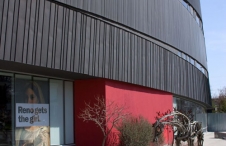Edward W. Yates
After accepting an offer to join the faculty of the Department of Art at the University of Nevada (UNR) in 1952, Edward W. Yates left his native Oklahoma and, for the next seventeen years, offered instruction in a variety of disciplines including sculpture, jewelry, and art history.
One of Yates' works is among the earliest examples of modern public art in Reno–a six-section bronze and wood sculpture titled "The Nature of Nevada." This high-relief work of art was affixed to a wall in the lobby of the First National Bank of Nevada at the corner of South Virginia and West First Streets in 1963. FNB executive Bert Fitz had obtained the commission for his friend, Yates. The artist carved the four white teakwood sections in his studio-garage at home and set up a foundry at the university specifically to cast the two bronze pieces using the lost-wax process. The resulting work of art remained at FNB until the late 1990s, when it was removed to the university–a second "permanent" home.
Yates was born in 1920 in the southeastern Oklahoma town of Antlers and graduated from Norman High School. He was inducted into the U. S. Army in 1942 and fought on several battlefronts across Europe during World War II, including the invasion at Normandy. Yates was the recipient of a Purple Heart. Following the war, he enrolled in the University of Oklahoma in Norman and earned an undergraduate degree in fine arts before going on to complete his Master of Fine Arts in 1950. During his years at OU, Yates met Craig Sheppard (1913-1978), a fellow graduate student. It was Sheppard who would be instrumental in bringing Yates to the university in Reno.
Japanese foundry methods became a matter of artistic and scholarly interest to Yates while he was at UNR. In 1962, he received a sabbatical leave and a Tiffany grant to study the lost-wax process of casting bronze in Japan. He spent a number of months at a small, rural foundry, and the result was a documentary film that was distributed by the Smithsonian Institute and Freer Gallery.
Yates retired from UNR in 1968 and moved on to a second career in teaching, this time at Earlham College in Richmond, Indiana. He retired from Earlham in 1976 and eventually returned to his roots in Okahoma, to sultry days fishing in bass-filled lakes and teaching watercolor painting at his local church. He died in Ardmore, Oklahoma, in the fall of 2001.
Article Locations
Related Articles
Further Reading
None at this time.


